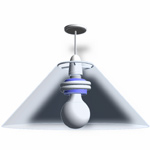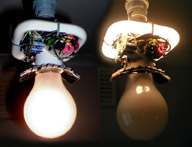The problem
of bulb failure
 We're
all familiar with bulb failure. Usually it happens when you flick the switch;
the light glows extra-bright for a second, then there's a dull 'pop' from
the bulb and the light goes out. Sometimes it happens when the bulb's been
lit for a few hours. With compact fluorescent ('energy saving') bulbs, the
failure may be more drawn out as the light becomes less bright over time,
or the ballast may fail. More...
We're
all familiar with bulb failure. Usually it happens when you flick the switch;
the light glows extra-bright for a second, then there's a dull 'pop' from
the bulb and the light goes out. Sometimes it happens when the bulb's been
lit for a few hours. With compact fluorescent ('energy saving') bulbs, the
failure may be more drawn out as the light becomes less bright over time,
or the ballast may fail. More...
For
many householders, bulb failure is an inconvenience: another chore, involving
searching for a spare bulb, climbing up on a chair, maybe with a cloth to
grip the hot failed bulb. For others, though, it can be both unsettling
and potentially dangerous, or a security risk. A simple solution to the
problem would offer significant benefits for consumers from many walks of
life: see The domestic
market.
For
institutional and commercial users, bulb failure can interfere with the
flow of business, distress or irritate customers or people using facilities,
and provide unwelcome diversion of manpower. There are many potential applications
for a lighting backup device: for more details, see The
commercial market.
How
often do bulbs fail? General Electric - one of the largest bulb manufacturers
- puts the life of a normal incandescent filament bulb at 1,000 hours, and
that of its 'Eco' range of compact fluorescents at 6,000 hours [1]. Other
manufacturers and authorities claim anything up to a 15,000 hour lifetime
for compact fluorescents [2] though the norm is probably around 8,000 hours
[3].
In
practice this means that, in a normal household setting with a light on
for an average of 5 hours a day (more in winter, less in summer), a incandescent
bulb will last around 6 months before failing. When you have multiple
bulbs, it's likely that one will fail every month or so. In a business
or institutional environment, where lighting may be on continuously, bulb
failures are much more common still. At 9 hours a day, a small business
with ten 8,000 hour life compact fluorescents will still have one fail every
three months on average.
Bulbs'
lifetime (both incandescent filament and compact fluorescent) can depend
on a number of factors including the stability of the mains supply, and
the amount of vibration to which the bulbs are subjected ('rough service'
bulbs with extra supports for the filaments are available, at a greater
cost).
[1]
GE Eco Energy Saving 9W CFL packaging, purchased at B&Q Slough, May
'06
[2] Tickell, O. "Bright
idea", Guardian, 7.xii.2005
[3] 'Compact
fluorescent lamp', Wikipedia, accessed 17.vii.2006
The solution
 Incluminate
fits into a light socket, with the bulb (incandescent filament or compact
fluorescent) plugged into it in turn. When the bulb fails, Incluminate automatically
illuminates a built-in backup light to give a similar level of lighting in
the room.
Incluminate
fits into a light socket, with the bulb (incandescent filament or compact
fluorescent) plugged into it in turn. When the bulb fails, Incluminate automatically
illuminates a built-in backup light to give a similar level of lighting in
the room.
You can
thus choose to replace the failed bulb at a more convenient time. There's
no immediate pressure: Incluminate's backup light will last many thousands
of hours. More...
Incluminate
is designed to fit into a standard bayonet light socket (an Edison screw version
would also be available); it's a compact device, intended to be unobtrusive.
The aesthetic models and renderings shown here are examples to illustrate
possible forms rather than the definitive shape of the product.
The dimensions
of Incluminate are such that with a normal incandescent filament bulb fitted,
it's no longer than a standard compact fluorescent, so it should fit in
lampshades or globes with restricted room ahead of the socket. Incluminate's
sensor system (patent applied for) allows a wide variety of bulbs to be
fitted and monitored, from low-wattage coloured candle bulbs right up to
extra-bright 150W incandescent globes.
Development
 A
series of proof-of-principle prototypes have been built to test and refine
Incluminate's function, and to support the draughting of patent applications.
The product's aesthetics are also under development; the aim is for the production
version of Incluminate to be as compact and unobtrusive as possible. Much
of the current development is focused on reducing the size of the device;
the functional prototypes are significantly larger than necessary to give
good access to the electronics for testing and development. More...
A
series of proof-of-principle prototypes have been built to test and refine
Incluminate's function, and to support the draughting of patent applications.
The product's aesthetics are also under development; the aim is for the production
version of Incluminate to be as compact and unobtrusive as possible. Much
of the current development is focused on reducing the size of the device;
the functional prototypes are significantly larger than necessary to give
good access to the electronics for testing and development. More...
Moving forward
 Incluminate
recently won a 2006 IKB Engineering Award (details)
and I am developing it further, along with investigation of the market. I've
applied for a British patent and have received very useful advice via g2i,
which has helped me plan how to move forward with the project.
Incluminate
recently won a 2006 IKB Engineering Award (details)
and I am developing it further, along with investigation of the market. I've
applied for a British patent and have received very useful advice via g2i,
which has helped me plan how to move forward with the project.
My current
priorities include analysing and segmenting the likely markets for Incluminate,
with a view to compiling a credible business plan. This will, in turn, enable
me to attract funding for the project, which will allow me to concentrate
more fully on it and accelerate the development of prototypes, design for
manufacture and a testing programme.
As such,
any comments or suggestions from potential users—domestic or commercial—or
anyone else interested in the product would be very gratefully received.
Development partners, licensees, investors or distributors are also sought:
please do get in touch.
<<
Home

 We're
all familiar with bulb failure. Usually it happens when you flick the switch;
the light glows extra-bright for a second, then there's a dull 'pop' from
the bulb and the light goes out. Sometimes it happens when the bulb's been
lit for a few hours. With compact fluorescent ('energy saving') bulbs, the
failure may be more drawn out as the light becomes less bright over time,
or the ballast may fail. More...
We're
all familiar with bulb failure. Usually it happens when you flick the switch;
the light glows extra-bright for a second, then there's a dull 'pop' from
the bulb and the light goes out. Sometimes it happens when the bulb's been
lit for a few hours. With compact fluorescent ('energy saving') bulbs, the
failure may be more drawn out as the light becomes less bright over time,
or the ballast may fail. More...
 Incluminate
fits into a light socket, with the bulb (incandescent filament or compact
fluorescent) plugged into it in turn. When the bulb fails, Incluminate automatically
illuminates a built-in backup light to give a similar level of lighting in
the room.
Incluminate
fits into a light socket, with the bulb (incandescent filament or compact
fluorescent) plugged into it in turn. When the bulb fails, Incluminate automatically
illuminates a built-in backup light to give a similar level of lighting in
the room.  A
series of proof-of-principle prototypes have been built to test and refine
Incluminate's function, and to support the draughting of patent applications.
The product's aesthetics are also under development; the aim is for the production
version of Incluminate to be as compact and unobtrusive as possible. Much
of the current development is focused on reducing the size of the device;
the functional prototypes are significantly larger than necessary to give
good access to the electronics for testing and development. More...
A
series of proof-of-principle prototypes have been built to test and refine
Incluminate's function, and to support the draughting of patent applications.
The product's aesthetics are also under development; the aim is for the production
version of Incluminate to be as compact and unobtrusive as possible. Much
of the current development is focused on reducing the size of the device;
the functional prototypes are significantly larger than necessary to give
good access to the electronics for testing and development. More... Incluminate
recently won a 2006 IKB Engineering Award (details)
and I am developing it further, along with investigation of the market. I've
applied for a British patent and have received very useful advice via g2i,
which has helped me plan how to move forward with the project.
Incluminate
recently won a 2006 IKB Engineering Award (details)
and I am developing it further, along with investigation of the market. I've
applied for a British patent and have received very useful advice via g2i,
which has helped me plan how to move forward with the project.